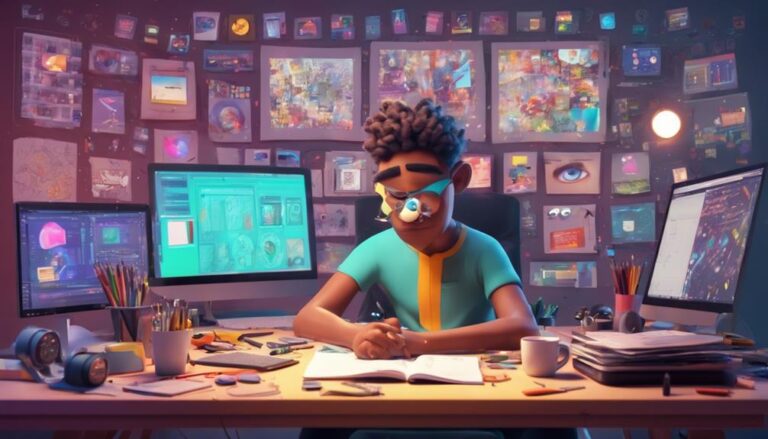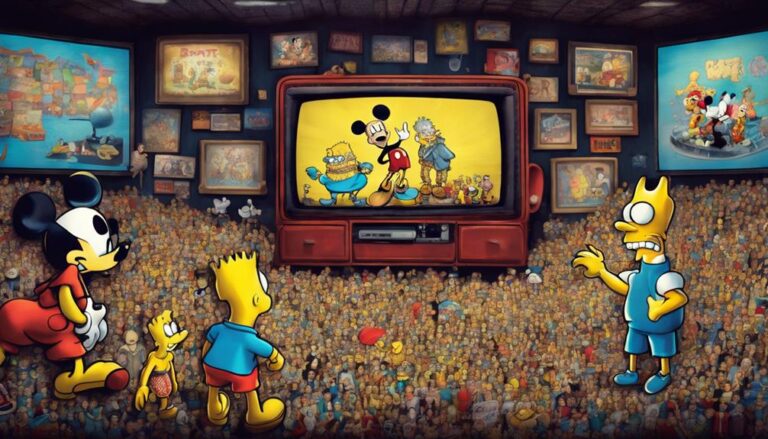What Defines a Inspired Graphic Novel Style?
You step into the world of inspired graphic novels when visual metaphors evoke emotions and associations, balance between text and image creates an immersive experience, and color palettes craft a symphony of feelings. Every panel is a deliberate beat, building tension or release, while the illustrative style infuses each page with a tone that resonates with the narrative's emotional core. As you enter this rich, immersive world, the boundaries between reality and fantasy blur, and the story begins to seep into your subconscious, lingering long after you turn the page, beckoning you to return to its vibrant, emotive landscape.
Key Takeaways
- A inspired graphic novel style balances text and image, guiding the reader's eye through the narrative with a clear hierarchy and emotional resonance.
- Visual metaphors and a distinct illustrative style evoke emotions and associations, adding depth and tone to the narrative.
- A keen sense of color, panel layout, and pacing crafts a symphony of emotions, drawing readers deeper into the story.
- Expressive anatomy and artistic liberties reveal character psyches, influencing pacing and mood.
Visual Storytelling Essentials
As you set out on the journey of crafting an inspired graphic novel, you'll discover that visual storytelling essentials are the foundation upon which your narrative is built. These essentials are the building blocks that bring your story to life, allowing you to convey complex emotions, themes, and ideas in a way that's both intuitive and impactful.
One of the most powerful visual storytelling devices at your disposal is the visual metaphor. By using metaphors, you can tap into your readers' subconscious, evoking emotions and associations that add depth and complexity to your narrative.
For instance, you might use a stormy sky to convey turmoil, or a blooming flower to symbolize growth. These metaphors become a visual language, allowing you to convey meaning beyond the literal interpretation of your words.
As you craft your graphic novel, remember that visual storytelling essentials aren't just about aesthetics; they're about creating a rich, immersive experience that draws your readers in and refuses to let them go.
Balancing Text and Image
With your visual storytelling foundations in place, you're now ready to orchestrate the delicate dance between text and image, harmonizing the rhythm of words and pictures to create a symphony of storytelling.
As you balance text and image, remember that each element has its own unique role to play. Establish a clear text hierarchy, guiding the reader's eye through the narrative with headings, captions, and speech bubbles. This will help create a sense of flow and pacing, drawing the reader deeper into your story.
But don't forget the power of image dominance. Sometimes, an evocative image can convey more emotion and meaning than a page of text.
Use visual elements to set the tone, create atmosphere, and evoke emotions. By striking the right balance between text and image, you'll create a narrative that's both engaging and immersive.
Emotional Resonance Through Color
You wield color like a master painter, evoking emotions and conjuring moods that draw your readers deeper into the world you've created.
With a keen sense of atmosphere creation, you craft a visual narrative that resonates with your audience on a primal level. Your palette is a symphony of emotions, with each hue and shade expertly tuned to evoke a specific response.
Blues and purples whisper secrets of mystery and intrigue, while warm oranges and yellows burst forth with energy and excitement. You're a master of mood evocation, conjuring the eerie unease of a deserted alleyway or the warm comfort of a cozy café.
As readers immerse themselves in your graphic novel, they're enveloped by the emotional resonance of your color choices. Your world comes alive, pulsing with the rhythm of your narrative.
The subtle nuances of your palette create a rich tapestry of feeling, drawing readers deeper into the story with each turn of the page. With color, you weave a spell of emotional connection, crafting a reading experience that lingers long after the final panel.
Panel Layout and Pacing
Now, you orchestrate the rhythm of your narrative, choreographing the dance of panels and pacing to guide your readers through the emotional landscape you've created.
Every panel is a deliberate beat, building tension, suspense, or release. You masterfully manipulate grid variations to control the flow of information, creating a sense of urgency or calm.
Wide panels sweep readers into sprawling landscapes, while narrow ones focus their attention on intimate moments.
You're a conductor, expertly guiding readers' eyes through the page. Panel flow is key, as you balance action and quiet, darkness and light.
You cleverly use whitespace to create pauses, allowing readers to absorb the emotional weight of a scene.
The pace quickens, and the panels shrink, as the action intensifies.
You're a storyteller, weaving a complex tapestry of visuals and silence. With every turn of the page, you raise the stakes, drawing readers deeper into your narrative.
Your panel layout and pacing are the heartbeat of your graphic novel, pulsing with energy and emotion.
Illustrative Style and Tone
Vibrant hues and bold lines converge to forge your graphic novel's distinct illustrative style, infusing every page with a tone that resonates deeply with your narrative's emotional core.
As you craft your visual language, you're free to take artistic liberties, experimenting with unconventional shapes, textures, and colors to convey the essence of your story. Every character's expressive anatomy becomes a window into their psyche, revealing their fears, desires, and motivations.
The way you distort or exaggerate their features can amplify the emotional impact of each scene, drawing readers into the heart of the narrative.
Your illustrative style can also influence the pacing and mood of your graphic novel. Dark, muted tones can create a sense of foreboding, while bright, whimsical colors can evoke a sense of wonder.
By balancing contrast, texture, and composition, you can orchestrate the emotional flow of your story, guiding readers through moments of tension, release, and introspection.
As you refine your unique illustrative style, remember that every artistic choice is an opportunity to deepen the emotional connection between your characters and your audience.
Frequently Asked Questions
How Do I Protect My Work From Being Plagiarized or Stolen?
You safeguard your art by running originality checks and registering with Creative Commons, ensuring your unique voice isn't silenced by thieves – your passion and creativity are worth protecting, after all!
Can I Use Copyrighted Characters or Settings in My Graphic Novel?
You're tempted to borrow beloved characters, but beware: using copyrighted ones without permission is illegal. Instead, try fan fiction or character reinterpretation, where you reimagine icons in new, original ways that pay homage without infringing.
What Software or Tools Do Professional Graphic Novelists Use?
You're ready to bring your graphic novel to life! Professionals often use Adobe Animate, Clip Studio Paint, or Manga Studio for digital inking, mastering brush techniques that evoke emotion and energy in every stroke.
How Do I Find a Publisher or Get My Work Noticed?
"You'll boost your chances of getting noticed by building a strong online presence, leveraging social media to showcase your work, and engaging with potential publishers and fans alike – it's time to shine and share your graphic novel with the world!"
Can I Create a Graphic Novel Solo, or Do I Need a Team?
You're wondering if you can fly solo on your graphic novel, and the answer is yes! Embrace the solo workflow and savor the creative control, allowing your unique vision to shine through every panel and page.
Conclusion
As you close the cover on your graphic novel, the inspired style lingers, a symphony of visual storytelling, balancing text and image in perfect harmony.
Emotional resonance echoes through color, panel layout, and pacing, crafting an unforgettable experience.
The illustrative style and tone resonate deep, evoking emotions that linger long after the final page is turned.






